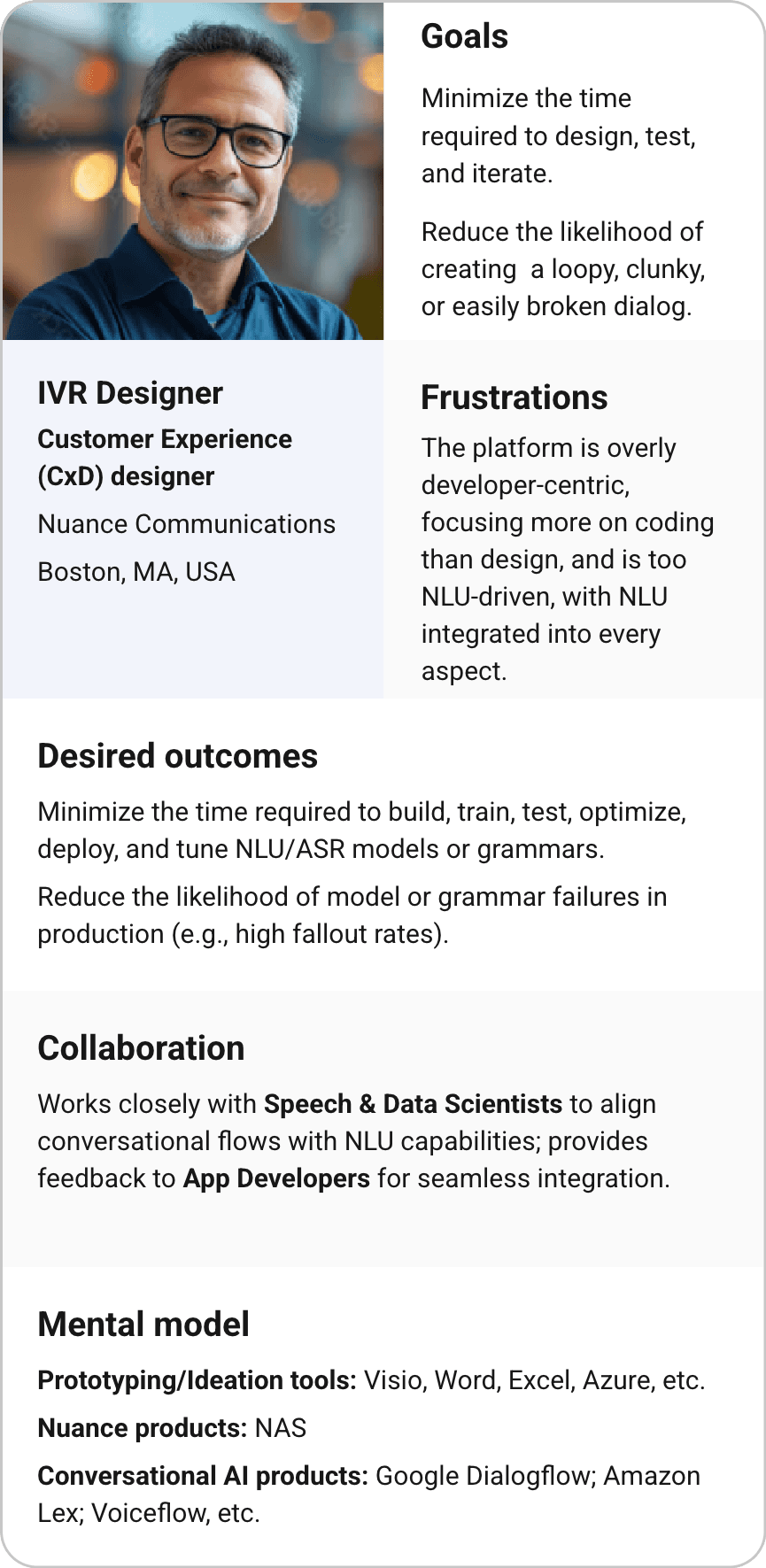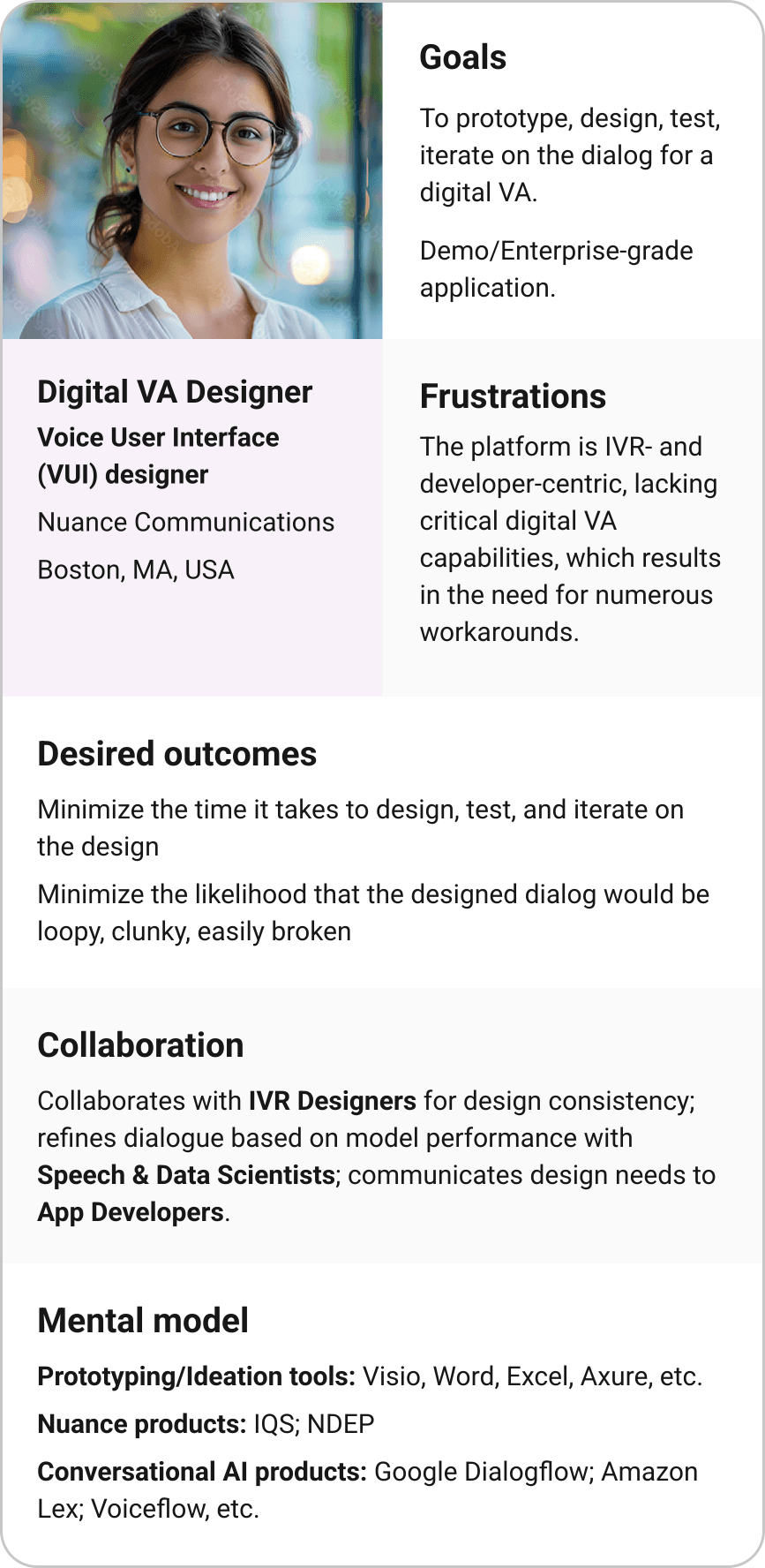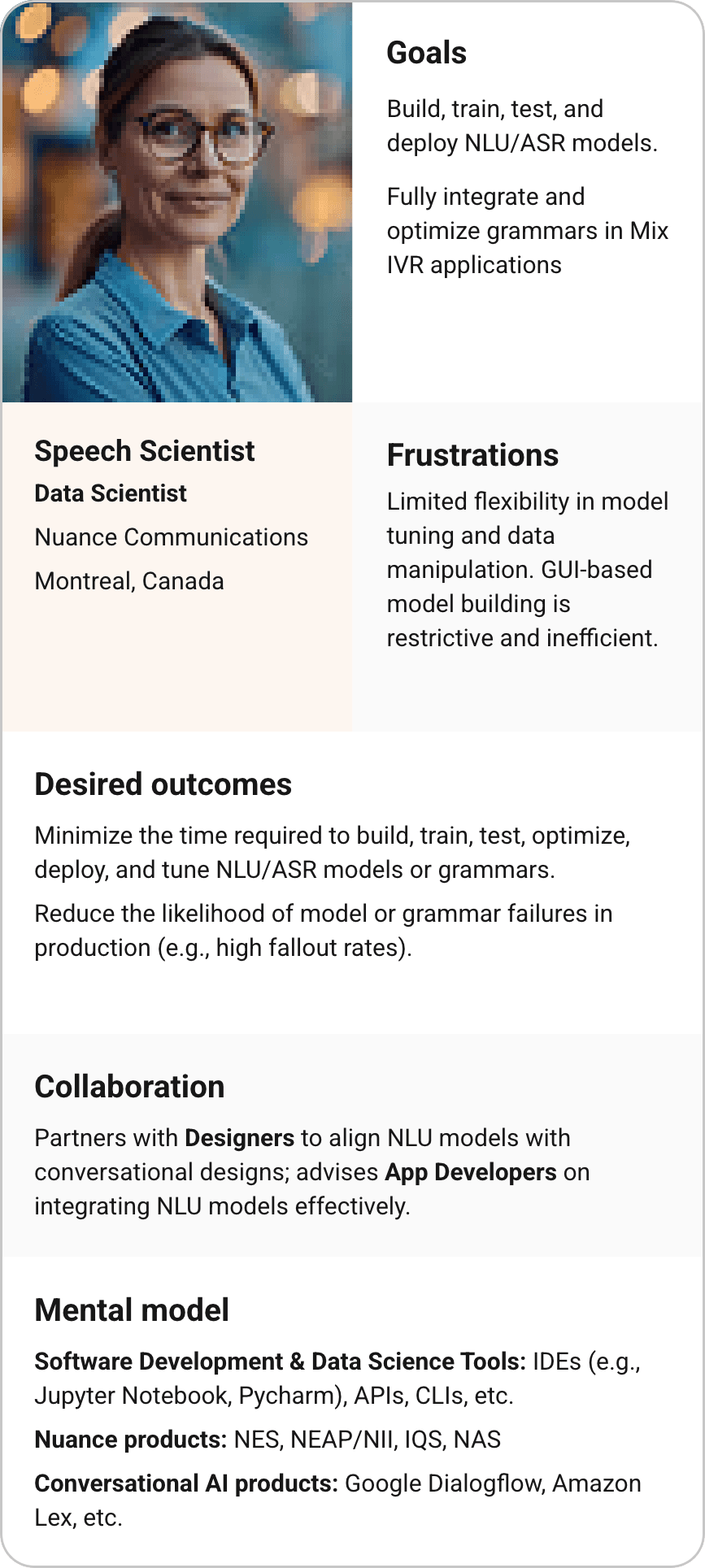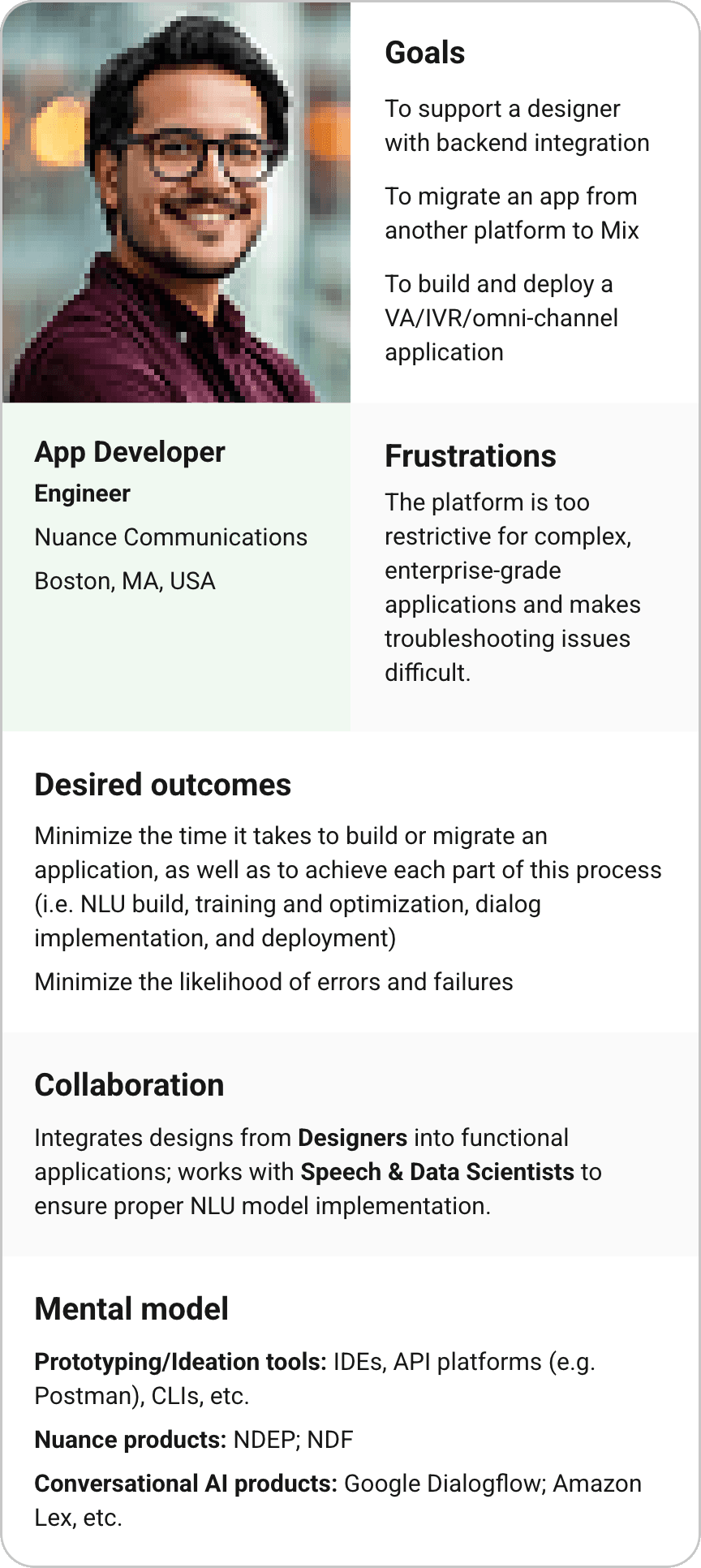Balancing Simplicity and Complexity for All Users
Visual UX/UI Design
Information Architecture
NLU Design Expertise
Scalable Design Solutions
Collaborative Design Leadership
Branding
My role:
Visual UX Design Team Lead + Developer Relations
Tools:
Figma, JIRA, Adobe Illustrator
Natural Language Understanding (NLU) empowers machines to interpret human language accurately, fostering meaningful interactions. At Nuance Communications, I led the design of Mix NLU, a tool enabling designers, speech scientists, and developers to create and manage NLU models. The primary challenge was crafting a solution that serves both beginners with intuitive simplicity and experts with advanced functionalities.
Skills:
Human-Centered Design, User Experience Design, Interaction Design, Information Architecture, Prototyping, Visual Design, Design Systems, User Research, Cross-Functional Collaboration, Data-Driven Design, Accessibility, Micro-Interactions
Project Overview
The problem
We needed to accommodate a diverse user base:
Beginners
Non-technical users, including designers, who require a simple, intuitive interface to guide them through model creation.
Experts
Speech scientists and developers who need advanced functionality, customization, and control.
The solution had to be approachable for beginners while remaining robust for experts, ensuring a smooth user experience across skill levels.
Key Insights
User research revealed:
Beginners
These users often felt overwhelmed by NLU's complexity, leading to abandonment of model creation.
Experts
These users were frustrated by limited flexibility, prompting them to use external tools.
This highlighted the need for a dual-purpose design that is both approachable for novices and powerful for experts, fostering collaboration across user types.
Design Approach
Our user-centered, iterative design process included user research with In-depth interviews and usability testing with all personas.
To understand our users deeply and facilitate collaboration between them, we developed concise personas highlighting their goals, challenges, and how they interact with each other to achieve a successful NLU model.
Multi-User Journey Mapping
Applying Insight to Design
Visualizing how different users interact with the tool and each other. By understanding these personas and their interactions, we tailored our design to facilitate collaboration while addressing individual needs.
Beginners
Experts
Solution
Two-Tiered Interface Design
To balance the need of simplicity and complexity, we developed two distinct tabs to address the needs of both.
Beginners | Develop tab
Featuring a purposefully designed visual interface that guides users in building their first NLU model while allowing flexibility for the iterative process inherent to model creation.
Create your first working NLU model in 5 minutes or less.


Learning center

In-tool education

Mix community
Offering experts advanced functionality, such as automation and generative AI, to help users refine and scale their models with greater flexibility and speed.

Machine learning

AI Automation

Mix forums
This approach ensured that each user group received tailored tools and frameworks, while maintaining a cohesive design system.
The Discover tab introduces a third layer to the solution by providing real-time data insights. This feature allows users to analyze actual user interactions, identify trends, and refine their NLU models based on real-world usage, enhancing accuracy and relevance.
Effortlessly optimize your model with real-world data, ensuring accuracy and performance seamlessly integrated!
Information Architecture (IA)
The IA for each tab was meticulously crafted to meet the distinct needs of both beginners and experts, ensuring that all users had access to appropriate tools and workflows based on their expertise.
Simplify the NLU model-building process for non-technical users.
The interface follows a strongly suggested linear visual workflow to help beginners understand how the components of an NLU model relate to one another. The visual hierarchy guides users step-by-step, starting with intents, moving to entities, and gradually introducing more complex model-building elements.
Educational Materials
Integrated tutorials, tooltips, and onboarding guides to lower the barrier to entry.
Sample Projects
Offered pre-configured templates and sample projects to reduce cognitive load.
Scalability
The IA was designed with scalability in mind, allowing new features or steps to be added without disrupting the core user experience.
Ask the expert
Office hours with expert users provide additional learning opportunities for new and intermediate users.
Provide flexible, customizable access to data and model-tuning functionality for advanced users.
The interface allows for flexible manipulation of data views, giving users access to key datasets and advanced automation and generative AI features. These AI tools enable users to build an NLU corpus more quickly, allowing them to focus on optimizing data for accuracy.
In-tool links to topic-specific content are available for all users, regardless of skill level.
Cross-User Collaboration
While the Optimize tab caters to advanced users, the tool allows experts to collaborate with beginners by seamlessly sharing models or best practices, fostering teamwork across user types.
User Testing Validation
User feedback from expert users during testing confirmed the importance of flexible views and automation features, which were iteratively refined based on real-world use cases.
Interaction Design (IxD)
Interaction design was crafted with all users in mind, prioritizing human-centered design to ensure a cohesive experience for beginners and experts alike.
Intuitive Task Flows
Tasks such as creating intents and defining entities were designed as clear, single interactions to help beginners focus on one step at a time. Special attention was given to empty states, which provided guidance and education at key moments. Tooltips were also used to offer additional context where needed.
“OrderCoffee” intent created.
Entity not added.
An entity with the same name already exists.
Real-Time Feedback
Beginners received immediate feedback throughout the process. Toast notifications confirmed actions, while clear error handling helped guide users toward successful outcomes, reducing mistakes.
Progressive Disclosure
Advanced features were accessible but not required for beginners. Users could explore these options without the risk of breaking their models, allowing them to learn at their own pace.
Simplified workflows, real-time feedback, sample projects, integrated educational resources, and accessibility features that reduce complexity and make NLU model building approachable.
A guided, linear workflow that takes beginners through the process of building an NLU model step-by-step. Starting with intents, moving to entities, and gradually increasing in complexity, this feature helps non-technical users stay on track without feeling overwhelmed.
Impact:
Provides structure, reduces cognitive load, and builds user confidence, making NLU model creation approachable for users with no prior experience.
As users input data and create models, the tool provides instant feedback via toast notifications, error handling, and tooltips. This helps beginners understand whether they are on the right track without needing to wait for deployment.
Impact:
Immediate feedback helps users learn and correct mistakes in real time, increasing their sense of accomplishment and reducing frustration.
Sample projects give users a basic model to start from, simplifying the model-building process. These samples serve as practical examples to illustrate the different elements of an NLU model.
This section provides a quick way to get started with Mix hands-on videos.

Video

NLU model

Dialog model
Mix NLU model
Mix Dialog model
Mix Test Chat
Impact:
Reduced the learning curve by providing users with a starting point, helping them to create models more quickly and with fewer errors.
Integrated educational resources such as tooltips, help guides, and onboarding tutorials walk beginners through the fundamentals of NLU as they build their models. This provides learning support without interrupting the flow of their work.
Tool tips can explain the ambiguity behind a label or icon.
Example above highlights the capability to mask data.
In-tool education enables users to work faster without needing to consult external documentation.
Entity types include List, Relationship, Freeform, Regex-based and Rule-based.
Impact:
Reduces the need for external research or training, empowering beginners to succeed on their own within the tool.
Enable expert users to fine-tune and optimize NLU models with precision and control, offering full flexibility to view and manipulate large datasets—unlike the beginner-focused Develop tab, which limits intent views to an individual basis—allowing experts to work across multiple intents and entities within an NLU corpus for advanced model optimization.
Impact:
Allows for personalized workspaces that cater to the needs of advanced users, enabling faster decision-making and more precise model optimization.
Automation classifies and annotates sample sentences, significantly reducing repetitive tasks. Once an initial framework is established for the NLU model, this feature saves hours of tedious work.
Impact:
By automating labor-intensive processes, the tool enhances productivity while keeping experts in control of how and when AI-generated content is applied to their models.
Leverages ChatGPT to generate sample sets, reducing the tedious task of creating large datasets of sample sentences for training and testing NLU models.
New and novice users can generate up to 10 sentences at a time on the Develop tab, with automatic integration into their dataset. This user-friendly feature ensures a seamless start while highlighting the potential of AI.
Based on user research, expert users requested a review process to ensure precision and control, enabling them to refine and curate data before integration—critical for maintaining high-quality NLU models.
Impact:
Streamlines dataset creation, saving time and effort while providing diverse and high-quality samples to enhance model performance.
Experts can easily share models, workflows, and best practices with beginners through the tool. This allows teams with varying expertise levels to work together on the same projects, improving overall collaboration.
Impact: Promotes teamwork between users with different skill sets, enabling a scalable, cross-functional approach to NLU model development and implementation.
The interface is designed with accessibility in mind, including features such as high-contrast modes, text-to-speech compatibility, keyboard navigation, and tooltips to assist users with disabilities.
Impact:
Ensures that the tool can be used by all users, regardless of their abilities, creating an inclusive user experience.
The "Aha!" Moment
The Try Tab
The Try tab was the breakthrough feature that spanned all tabs, enabling both beginner and expert users to test and validate their models instantly.
No Deployment Required
Users didn’t need to deploy the model to test it, making it especially valuable for beginners unfamiliar with deployment processes.
The tab provided the corresponding JSON output for each test, allowing for easy integration into real applications.
This hands-on testing feature was a key moment that enhanced user engagement and accelerated adoption, as it gave users immediate feedback and a sense of accomplishment.
The success of the Mix NLU tool was significantly supported by an effective branding and education strategy, which played a pivotal role in increasing user adoption and retention.
Educational Materials
Extensive educational resources, including tutorials, in-tool help sections, and onboarding guides, supported beginners in learning both NLU concepts and how to use the Mix NLU tool effectively.
Brand Strategy
The branding for Mix NLU was crafted to be inviting, approachable, and memorable, creating a sense of connection with users in an otherwise complex enterprise-driven space. We developed a playful mascot, Max, who became the face of Mix NLU. This branding extended into marketing campaigns, educational content, and even swag, building strong brand loyalty.
Impact on User Engagement
The combination of user-friendly education and relatable branding fostered a sense of community and trust, encouraging users to continue exploring the tool. This helped increase user satisfaction and adoption rates significantly.
The Mix NLU tool successfully balanced the needs of both beginner and expert users through thoughtful design, user-friendly features, and strong branding.











































